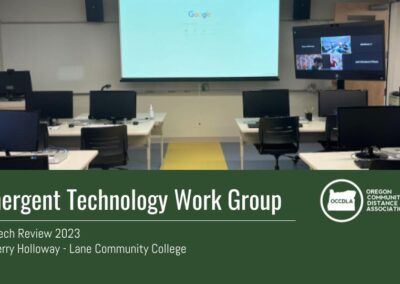EMERGENT TECHNOLOGY WORK GROUP - ED TECH REVIEWS
SWIVL: Tracking Robot but not in a “Terminator” way
by Rob Kovacich
Chemistry Instructor and Moodle Administrator
Columbia Gorge Community College
May 14th, 2019
Key Features:
- Tracking a Speaker
- Multiple Microphones
- Multiple Camera Option, with multiple devices
- Device Interface
Exploration Intent
My hope was to record lectures, but not just me lecturing. I teach in a Socratic Method, there are a lot of questions asked of the students, and I wanted a device that would be able to record the students answers as much as my lecturing. The goal was for a student that was not in class that day to learn the content through our discussions of questions and answers. Student questions and answers are a powerful part learning and I did not want the no-shows to miss out on that learning.
Having our campus in the Columbia River Gorge, so close to Mt Hood and Adams can be a challenge during winter term. This year we missed 9 days. I was interested in giving my students the opportunity to not attend class, but still feel apart of what happened in class.
Lessons Learned
What I learned while exploring this technology is a great deal of frustration. First and foremost, you must have the correct version of an iPad or android device, not just correct software. The SWIVL is a robot, it does not have a camera, it simple pans the camera to the speaker and uses small microphones to pass the audio on to the device you with the camera. The SWIVL website stated that you needed a device with a particular iOS or Android OS, but this is not correct. Using and older device with the correct OS is does not meet the requirements. So, I thought our college had a viable iPad, but it was a generation too old and we were forced to purchase a newer iPad mini.
Secondly, and most importantly, the recordings were of very low quality. Both video and audio. Using a brand new iPad mini (the camera settings were set to maximum resolution) and the recording devices that came with the SWIVL, I was highly disappointed. Hard to read what is written on the dry erase board, even more difficult to see projected images.
Here are several other issues with the SWIVL:
- The app is not very intuitive.
- The app takes a long time to upload a video, surprisingly long time. It took a long time to process the video to make it watchable online.
- The video that is uploaded to the SWIVL Cloud is of a higher resolution than the one that can be exported to YouTube forcing you to use the SWIVL Cloud.
- The Pro-Version is basically required to get what you would really want out of a lecture capture video, and that costs $50 per year.
- The SWIVL is supposed to spin 360 degrees, and if you walk turtle slow it will, but if you walk with a normal gate past the robot it will not follow you, it gets confused.
- The charging requirements and setup is onerous. These tasks will add work to your week.
- The Marker is what the robot follows and is mic. The robot does a terrible job at panning around to the students that are answering a question.
Next Steps
I have no plans on using this technology in the future. I will willing return the product, if I am allowed. I passed it onto our I.T. tester to see if it was just me being dumb about this new technology, but she was just as unimpressed.
My plan going forward is to borrow the OWL system from another faculty member and test it in the same way I tested the SWIVL.
2021-23 ED TECH REVIEWS
TECHNOLOGY EXPLORATION
Do you have an emergent technology you would like to explore? Submit your nomination for a technology evaluation by the OCCDLA Emergent Technology Workgroup.
The OCCDLA Emergent Tech Work Group receives nominations for instructional technology review from work group members and our nomination form, available to all instructors and administrative staff of all Oregon Community Colleges.
Questions?
For questions about the Emergent Technology Work Group:
Administrative Contact:
Monica Marlo
Portland Community College
monica.martinezgallagher@pcc.edu



